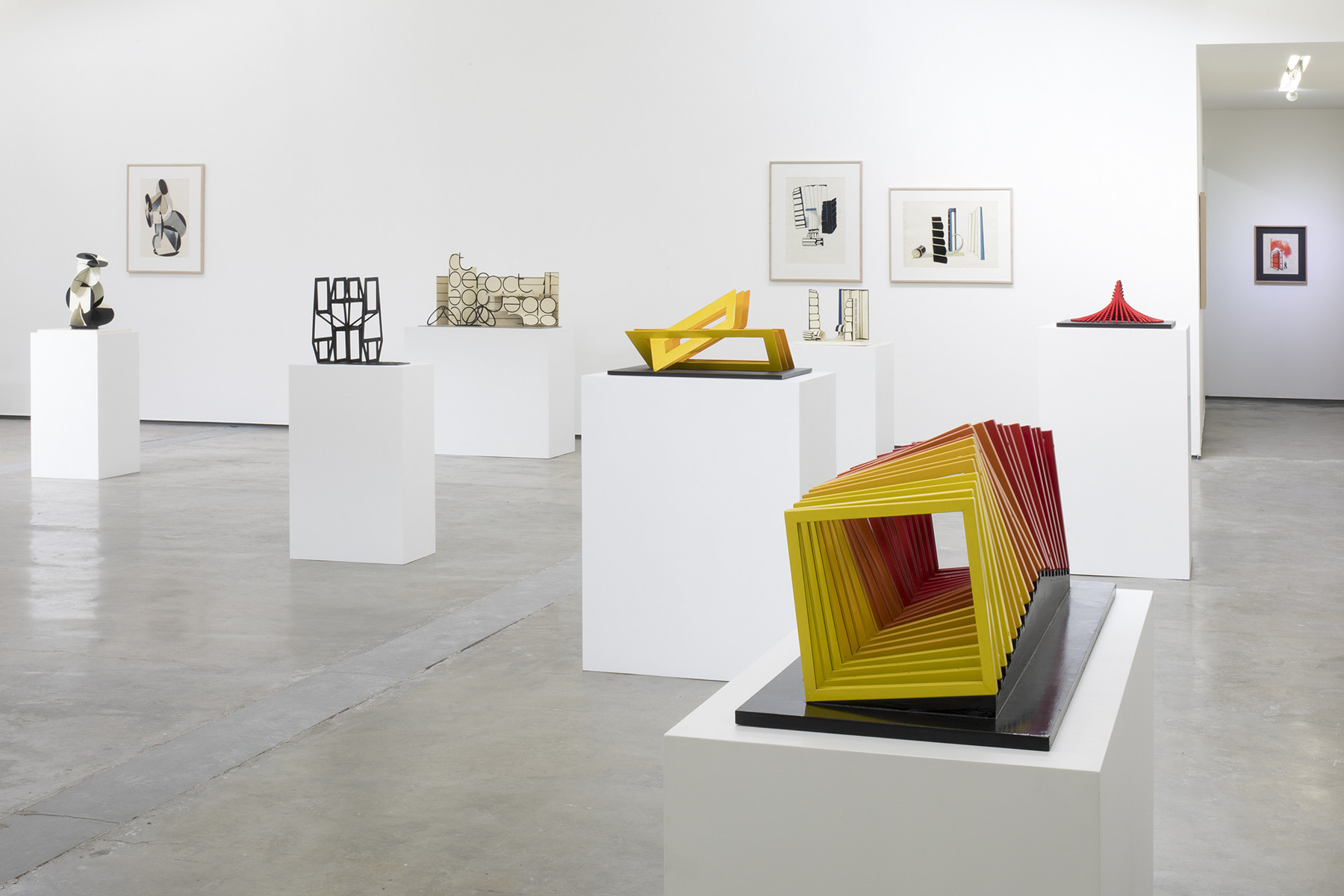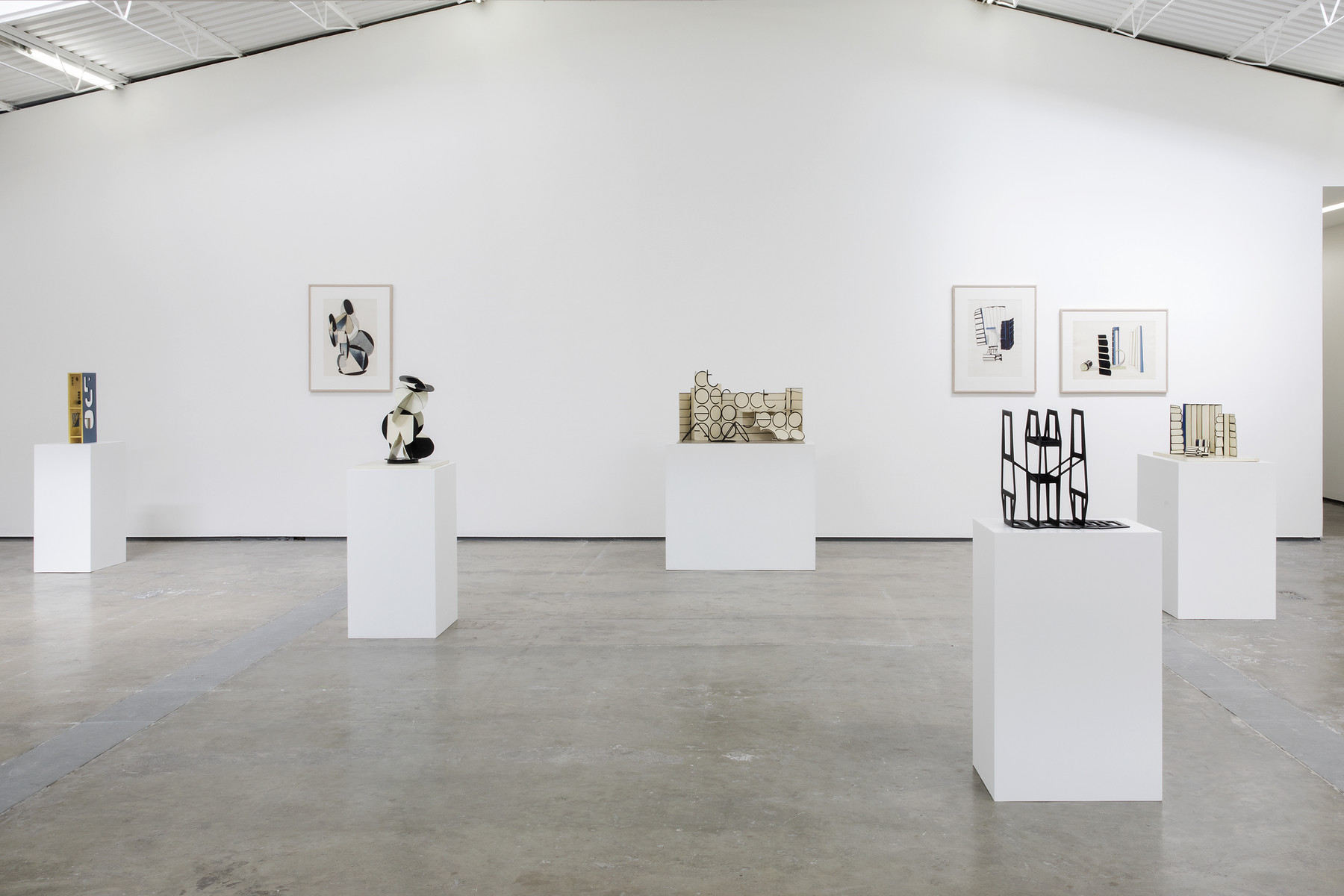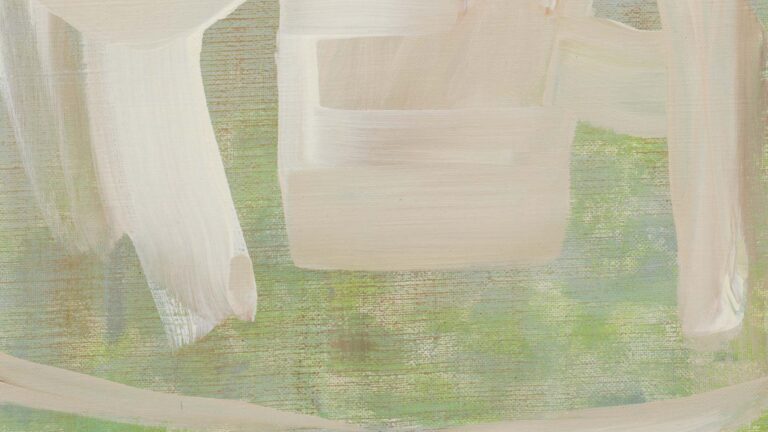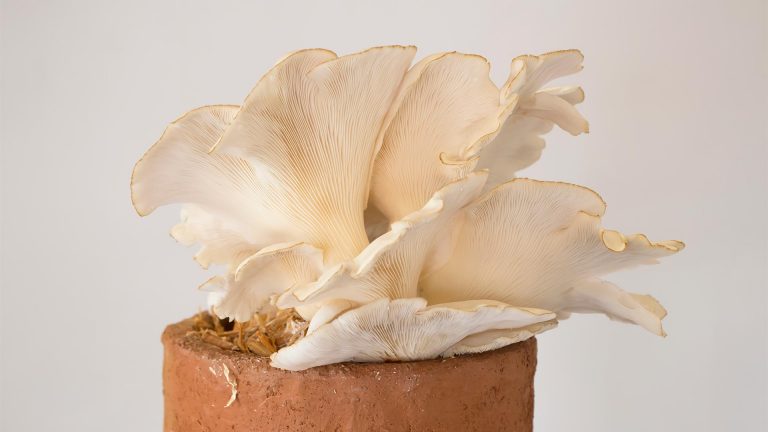Artist: Helen Escobedo
Exhibition title: The Potential of Sculpture
Venue: Proyectos Monclova, Mexico City, Mexico
Date: January 26 – March 9, 2019
Photography: all images copyright and courtesy of the artist and Proyectos Monclova, Mexico City
Helen Escobedo, or how to approach the public space from the private sphere
Rita Eder
The drawings and models that Escobedo conceived over several decades, particularly during the seventies, revealed her experimental capacity and her intelligence to transform the conventions of an artistic process. This becomes evident in her series of photomontages (a project in collaboration with the photographer Paolo Gori) and three-dimensional collages in which her sculptural proposals appear inserted into an urban – or natural environment, places where she would have liked to imagine her interventions. In Helen’s own words:
“If until now my research has led me to propose sculptural solutions within a specific environment, of which 10 percent succeeded in executed works and 90 percent exist as models, implying an in-depth investigation, (…) today they can exist as finished works thanks to this humorous and valid method. With this resource, I reject the frustrations of not seeing these projects. I am faced with the (…) opportunity to knock down my preset boundaries and opt for infinitely more flexible and straight-forward methods of creating works in imaginary situations of my choice.”[1]
Helen was an excellent draftswoman and her utopian projects and installations manifested in drawings and collages that often introduced a subversive object as a critical and humorous commentary on the urban space. Drawing was her medium of choice to develop ideas for ambitious projects. In those sketches she conceived complex images, indispensable to understand her work – particularly her intention to subvert established artistic practices – and her interest in processes, rather than in finished objects. I consider myself – she would say – a problem-solver. While referring to problems in relation to the medium of sculpture, she introduced the principle of functionality in art in the seventies, which led her towards architecture and design as methods and awoke her desire to consider herself an experimenter.
Focused on the solution of problems, the repeating signature of the artist disappeared, favoring specific responses to each given situation. Helen was interested in considering art as symbolic strategy to confront social issues or specific situations.
In her dialogue with the international avant-garde, she worked with the idea of counter-sense, although there was also a certain desire to correct the notions of integral design of the Bauhaus. And perhaps its for that reason that she refused to define form and to adopt the orthodoxy of the geometric language. She did not seek the perfection or rigidity of the orthogonal, instead she introduced organic shapes that arose from the reflection on more vital aspects: playfulness and melancholy that both intersect in her utopic drawings, proposing alternatives to the urban space.
The opportunity to intervene and transform the official idea of “monument” in Mexico for Escobedo came with Mathias Goeritz’ prolific project la Ruta de la Amistad (engl. Friendship Route) – a 17km long sculpture corridor, initiated for the Olympic Games held in Mexico in 1968 – and her sculptural contribution Puerta al viento.
A few years later, Helen Escobedo and Paolo Gori undertook a trip through Mexico, in order to research and record all official monuments in the country. This endeavor unveiled the need for change, and for exploration towards other possibilities of large -scale sculpture. As a result, Escobedo explored the notion of site-specificity, environment and installation in order to address socio-political and ecological issues in her work. Furthermore, the border became a crucial theme for the artist. In her iconic piece By the Night Tide, conceived for the second edition of inSite (1994) in Tijuana, the notion of resistance became striking. Here, Escobedo installed wire-mesh sculptures on the Mexican side of the border, resembling ships, armed with coconut-loaded catapults, suggesting a defiant, but quixotic counteroffensive against the Goliath next door.
On other occasions, she turned to the existential and tragic dimension of the human body while pointing to politically urgent topics such as migration and its consequences. At the same time, on a more formal level, her approach towards geometric abstraction always ended up emphasizing the organic. Massive volume appeared delicate and barely perceptible when Escobedo inserted it into natural landscape, while introducing some few architectonic, transparent elements. As Graciela Shmilchuk observed in Pasos en la arena, there is a clear intention to dematerialize the intervention, while almost seamlessly integrating it into its natural surrounding in gardens and forests.
The driving force behind Escobedo’s artistic explorations, as Jorge Reynoso Pohlenz points out, was her energetic lifestyle of constant travelling, multicultural encounters, her attraction for popular culture and interdisciplinarity. Helen aimed for a merging between art and life, she was concerned with ecological topics and thought outside predetermined disciplines. Its therefore that her avant-garde spirit, her humor (even in the most extreme circumstances), her good manners, her equation between form and content in her projects accompanied her until her last breath.
[1] Eder, Rita, Helen Escobedo, México, UNAM, 1982 (p.4)
Helen Escobedo: The Potential of the Sculpture, Installation view in Proyectos Monclova, Mexico City, Courtesy: The Estate of Helen Escobedo and Proyectos Monclova, Photo: Ramiro Chaves
Helen Escobedo: The Potential of the Sculpture, Installation view in Proyectos Monclova, Mexico City, Courtesy: The Estate of Helen Escobedo and Proyectos Monclova, Photo: Ramiro Chaves
Helen Escobedo: The Potential of the Sculpture, Installation view in Proyectos Monclova, Mexico City, Courtesy: The Estate of Helen Escobedo and Proyectos Monclova, Photo: Ramiro Chaves
Helen Escobedo: The Potential of the Sculpture, Installation view in Proyectos Monclova, Mexico City, Courtesy: The Estate of Helen Escobedo and Proyectos Monclova, Photo: Ramiro Chaves
Helen Escobedo: The Potential of the Sculpture, Installation view in Proyectos Monclova, Mexico City, Courtesy: The Estate of Helen Escobedo and Proyectos Monclova, Photo: Ramiro Chaves
Helen Escobedo: The Potential of the Sculpture, Installation view in Proyectos Monclova, Mexico City, Courtesy: The Estate of Helen Escobedo and Proyectos Monclova, Photo: Ramiro Chaves
Helen Escobedo: The Potential of the Sculpture, Installation view in Proyectos Monclova, Mexico City, Courtesy: The Estate of Helen Escobedo and Proyectos Monclova, Photo: Ramiro Chaves
Helen Escobedo: The Potential of the Sculpture, Installation view in Proyectos Monclova, Mexico City, Courtesy: The Estate of Helen Escobedo and Proyectos Monclova, Photo: Ramiro Chaves
Helen Escobedo: The Potential of the Sculpture, Installation view in Proyectos Monclova, Mexico City, Courtesy: The Estate of Helen Escobedo and Proyectos Monclova, Photo: Ramiro Chaves
Helen Escobedo: The Potential of the Sculpture, Installation view in Proyectos Monclova, Mexico City, Courtesy: The Estate of Helen Escobedo and Proyectos Monclova, Photo: Ramiro Chaves
Helen Escobedo: The Potential of the Sculpture, Installation view in Proyectos Monclova, Mexico City, Courtesy: The Estate of Helen Escobedo and Proyectos Monclova, Photo: Ramiro Chaves
Helen Escobedo: The Potential of the Sculpture, Installation view in Proyectos Monclova, Mexico City, Courtesy: The Estate of Helen Escobedo and Proyectos Monclova, Photo: Ramiro Chaves
Helen Escobedo: The Potential of the Sculpture, Installation view in Proyectos Monclova, Mexico City, Courtesy: The Estate of Helen Escobedo and Proyectos Monclova, Photo: Ramiro Chaves
Helen Escobedo: The Potential of the Sculpture, Installation view in Proyectos Monclova, Mexico City, Courtesy: The Estate of Helen Escobedo and Proyectos Monclova, Photo: Ramiro Chaves
Helen Escobedo: The Potential of the Sculpture, Installation view in Proyectos Monclova, Mexico City, Courtesy: The Estate of Helen Escobedo and Proyectos Monclova, Photo: Ramiro Chaves
Helen Escobedo: The Potential of the Sculpture, Installation view in Proyectos Monclova, Mexico City, Courtesy: The Estate of Helen Escobedo and Proyectos Monclova, Photo: Ramiro Chaves
Helen Escobedo: The Potential of the Sculpture, Installation view in Proyectos Monclova, Mexico City, Courtesy: The Estate of Helen Escobedo and Proyectos Monclova, Photo: Ramiro Chaves
Helen Escobedo: The Potential of the Sculpture, Installation view in Proyectos Monclova, Mexico City, Courtesy: The Estate of Helen Escobedo and Proyectos Monclova, Photo: Ramiro Chaves
Helen Escobedo: The Potential of the Sculpture, Installation view in Proyectos Monclova, Mexico City, Courtesy: The Estate of Helen Escobedo and Proyectos Monclova, Photo: Ramiro Chaves
Helen Escobedo: The Potential of the Sculpture, Installation view in Proyectos Monclova, Mexico City, Courtesy: The Estate of Helen Escobedo and Proyectos Monclova, Photo: Ramiro Chaves
Helen Escobedo: The Potential of the Sculpture, Installation view in Proyectos Monclova, Mexico City, Courtesy: The Estate of Helen Escobedo and Proyectos Monclova, Photo: Ramiro Chaves
Helen Escobedo: The Potential of the Sculpture, Installation view in Proyectos Monclova, Mexico City, Courtesy: The Estate of Helen Escobedo and Proyectos Monclova, Photo: Ramiro Chaves
HELEN ESCOBEDO, Homenaje a octubre, 1978, Lacquered wood, Dimensions: 13.58 x 13.78 in, 53.5 x 90 x 45 cm, Courtesy of The Estate of Helen Escobedo and PROYECTOSMONCLOVA, Photo: Ramiro Chaves
HELEN ESCOBEDO, Eclipse, from the series Muros Dinámicos, 1968, Lacquered wood, Dimensions: 79.13 x 29.92 x 28.74 in, 201 x 76 x 73 cm, Courtesy of The Estate of Helen Escobedo and PROYECTOSMONCLOVA, Photo: Ramiro Chaves
HELEN ESCOBEDO, Serie urbe, 1978, Collage and drawing on paper, Framed dimensions: 22.83 x 20.08 x 1.97 in, 58 x 51 x 5 cm, Courtesy of The Estate of Helen Escobedo and PROYECTOSMONCLOVA, Photo: Ramiro Chaves
HELEN ESCOBEDO, Untitled, 1974, Lacquered wood, Framed dimensions: 43.5 x 61.14 x 2.09 in, 110.5 x 155.3 x 5.3 cm, Courtesy of The Estate of Helen Escobedo and PROYECTOSMONCLOVA, Photo: Ramiro Chaves
HELEN ESCOBEDO, Interceptor – Serie urbe, 1978, Collage on paper, Framed dimensions: 22.83 x 20.08 x 1.97 in, 58 x 51 x 5 cm, Courtesy of The Estate of Helen Escobedo and PROYECTOSMONCLOVA, Photo: Ramiro Chaves
HELEN ESCOBEDO, Untitled, 1974, Lacquered wood, Framed dimensions: 43.46 x 61.18 x 2.05 in, 110.4 x 155.4 x 5.2 cm, Courtesy of The Estate of Helen Escobedo and PROYECTOSMONCLOVA, Photo: Ramiro Chaves
HELEN ESCOBEDO, Mecano doble, 1981, Lacquered aluminum, Dimensions: 9.65 x 23.66 x 19.69 in, 24.5 x 60.1 x 50 cm, Courtesy of The Estate of Helen Escobedo and PROYECTOSMONCLOVA, Photo: Ramiro Chaves
HELEN ESCOBEDO, Mecano (Ixtapalapa), 1981, Graphite and conté on paper, Dimensions: 35.39 x 27.52 x 1.38 in, 89.9 x 69.9 x 3.5 cm, Courtesy of The Estate of Helen Escobedo and PROYECTOSMONCLOVA, Photo: Ramiro Chaves




































